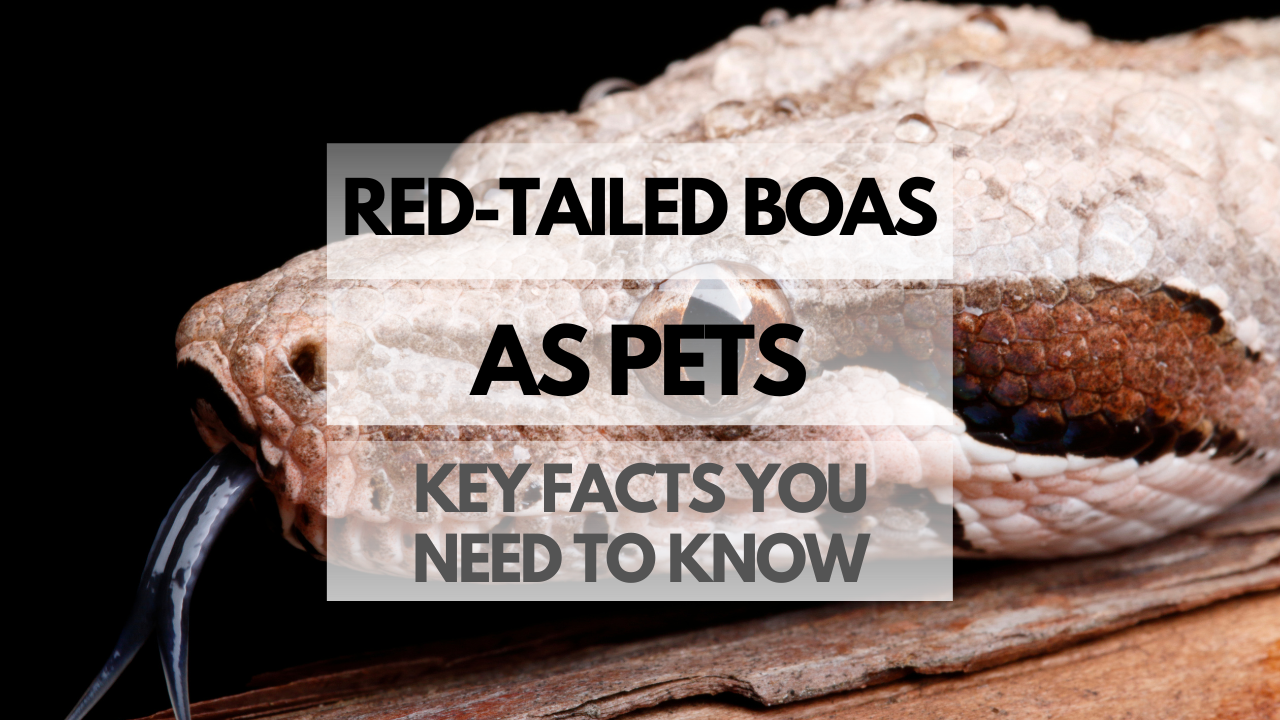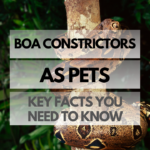Red-tailed boas, also known as boa constrictor constrictor, have gained popularity as pets due to their striking appearance and manageable size. In this article, we’ll explore everything you need to know about keeping red-tailed boas as pets, from their behavior and cost to their care and feeding requirements.
Quick Reference Table: Red-Tailed Boas Facts
| Fact | Detail |
|---|---|
| Average Lifespan | 20-30 years |
| Average Size | 6-10 feet |
| Temperament | Docile, tolerates handling |
| Diet | Obligate carnivore (rodents) |
| Native Habitat | Central and South America |
How Are Red-Tailed Boas as Pets?
Red-tailed boas make interesting and rewarding pets for dedicated and responsible owners. Their docile nature, impressive size, and beautiful appearance make them a popular choice among reptile enthusiasts.
Pros and Cons of Red-Tailed Boas
Pros:
- Beautiful appearance with distinctive markings
- Docile temperament and manageable size
- Long lifespan, providing a long-term pet relationship
Cons:
- Large size requires a spacious and well-maintained enclosure
- Require feeding of whole prey items, such as rodents
- Long lifespan requires a significant time commitment
Red-Tailed Boas Behavior and Temperament
Red-tailed boas are generally docile and tolerate handling well when accustomed to human interaction. They are solitary animals and should be housed individually. Although they are primarily nocturnal, they may be active during the day as well.
How Much Do Red-Tailed Boas Cost?
Red-tailed boas can range in price from $100 to over $1,000, depending on factors such as age, size, coloration, and rarity. Initial setup costs for an appropriate enclosure, heating, and lighting can range from $300 to $500. Ongoing expenses include food, substrate, and electricity for heating and lighting.
Red-Tailed Boas Lifespan: Time and Commitment
Red-tailed boas have a life expectancy of 20-30 years in captivity with proper care. Owners should be prepared for a long-term commitment to their pet, including regular cleaning and maintenance of the enclosure, feeding, and monitoring their health.
Red-Tailed Boas Size
Adult red-tailed boas typically reach lengths of 6-10 feet, with females generally being larger than males. They are a heavy-bodied snake, with adult females weighing between 20-40 pounds and adult males weighing between 10-20 pounds.
Red-Tailed Boas Species
There are several subspecies of the boa constrictor, but the red-tailed boa is specifically the boa constrictor constrictor. This subspecies is known for its distinctive red or reddish-brown tail markings and is native to Central and South America.
Red-Tailed Boas Colors, Looks and Appearances
Red-tailed boas have a background color ranging from tan to dark brown, with darker, irregularly-shaped saddle markings along their backs. Their most distinctive feature is their reddish-brown tail markings, which give them their common name.
Red-Tailed Boas Care Guide
Proper care for a red-tailed boa requires attention to their habitat, diet, and health. Let’s explore the essentials of red-tailed boa care.
Red-Tailed Boas Habitat: Tank and Housing
A suitable habitat is essential for the health and well-being of your red-tailed boa. Consider the following aspects when setting up their enclosure:
AppropriateRed-Tailed Boas Tank Size
Young boas can be housed in a 20-gallon long tank, but as they grow, they will require a larger enclosure. Adult boas need a minimum of a 4x2x2-foot enclosure, with larger enclosures being preferable for more active individuals.
Types of Enclosures
Glass, plastic, or wood enclosures can work well for red-tailed boas, provided they are well-ventilated and secure. Front-opening enclosures with sliding or hinged doors are ideal for easy access and cleaning.
Substrate Options
Aspen shavings, coconut husk, or cypress mulch make suitable substrates for red-tailed boas. These substrates help maintain humidity levels and are easy to clean.
Heating and Lighting Requirements
Red-tailed boas require a temperature gradient in their enclosure, with a basking area of 88-92°F and a cooler area of 75-80°F. A combination of under-tank heaters and overhead heat lamps can be used to achieve these temperatures. While UVB lighting is not essential for red-tailed boas, providing low-level UVB can be beneficial for their overall health.
Humidity and Temperature Control
Maintaining a humidity level of 50-70% is important for red-tailed boas. Use a hygrometer to monitor humidity levels and mist the enclosure as necessary to maintain appropriate humidity. Digital thermometers or infrared temperature guns can be used to monitor temperature gradients within the enclosure.
Furnishings and Decorations
Provide sturdy branches or shelves for climbing, as well as multiple hiding spots such as half logs, PVC pipes, or commercially available hide boxes. Ensure that the enclosure is well-secured to prevent escapes.
Cleaning and Maintenance
Spot clean the enclosure daily, removing any waste or soiled substrate. Perform a complete substrate change and sanitize the enclosure and furnishings every 4-6 weeks or as needed.
Red-Tailed Boas Food: Diet and Nutrition
A healthy diet is essential for the growth and well-being of your red-tailed boa. Here are some guidelines for feeding your boa:
Feeding Frequency and Schedule
Young boas should be fed every 7-10 days, while adult boas can be fed every 2-4 weeks. Adjust the feeding frequency based on your boa’s growth rate and body condition.
What do Red-Tailed Boas Eat?
Red-tailed boas are obligate carnivores and should be fed a diet of whole prey items, such as rodents. Choose a prey item that is appropriately sized for your boa, generally no larger than the widest part of their body.
Red-Tailed Boas Treats
While red-tailed boas do not require “treats” in their diet, offering a variety of prey items, such as rats, mice, and even small birds, can provide enrichment and help prevent boredom.
Foods to Avoid
Avoid feeding your red-tailed boa live prey, as it can pose a risk of injury to your snake. Stick to pre-killed or frozen-thawed prey items.
Supplements and Vitamins
When fed a diet of whole prey items, red-tailed boas generally do not require additional supplementation. However, consult with a reptile veterinarian if you have concerns about your boa’s nutrition.
Hydration
Provide a large, sturdy water dish for your red-tailed boa to drink from and to aid in maintaining humidity levels in the enclosure. Clean the water dish daily and refill with fresh water.
Handling and Socialization
Proper handling and socialization are essential for establishing a positive relationship with your red-tailed boa.
Taming and Bonding
Gradual, consistent handling is key to taming and bonding with your red-tailed boa. Begin with short handling sessions of about 5-10 minutes, gradually increasing the duration as your boa becomes more comfortable. Always handle your boa gently and with confidence.
Safe Handling Techniques
When handling your red-tailed boa, support its body with both hands, allowing the snake to move freely without feeling restrained. Avoid sudden movements and never grab the snake by its tail, as this can cause stress and injury.
Signs of Stress and Illness
Signs of stress in red-tailed boas can include rapid breathing, hissing, or striking. If your boa shows signs of stress during handling, give it some time to calm down before attempting to handle again. Regularly monitor your boa’s health, looking for signs of illness such as lethargy, loss of appetite, or changes in skin color or texture.
Introducing Red-Tailed Boas to Other Pets
Red-tailed boas are solitary animals and should not be housed with other snakes or pets. When introducing your boa to other household pets, always maintain a safe distance and supervise interactions closely to prevent injury or stress to either animal.
Health and Wellness
Ensuring the health and wellness of your red-tailed boa requires regular monitoring and preventative care.
Common Health Issues
Some common health issues in red-tailed boas include respiratory infections, mites, and shedding problems. Regularly inspect your boa’s enclosure for signs of illness, and consult with a reptile veterinarian if you have concerns about your boa’s health.
Signs of a Healthy Red-Tailed Boa
A healthy red-tailed boa will have clear eyes, smooth skin, a strong appetite, and regular shedding cycles. Monitor your boa’s behavior, appearance, and activity levels to ensure its ongoing health and well-being.
Preventative Care
Regular cleaning and maintenance of your boa’s enclosure, as well as proper temperature and humidity control, can help prevent many health issues. Provide a healthy diet and ensure that your boa has access to clean water at all times.
Finding a Reptile Veterinarian
Establish a relationship with a reptile veterinarian who is experienced in treating red-tailed boas. Regular check-ups and prompt treatment of any health issues are essential for your boa’s long-term health and well-being.
Breeding and Reproduction
Breeding red-tailed boas can be a fascinating and rewarding experience for dedicated snake enthusiasts. Here’s what you need to know about red-tailed boa reproduction:
Determining Gender
Sexing red-tailed boas can be difficult, as there are few external differences between males and females. A reptile veterinarian or experienced breeder can help you determine the gender of your boa through techniques such as probing or popping.
Mating Behavior and Courtship
During the breeding season, male red-tailed boas will court females by rubbing their bodies against the female and flicking their tongues. Successful mating can result in the female becoming gravid, or carrying fertilized eggs.
Gravidity and Egg-laying
Red-tailed boas are ovoviviparous, meaning they give birth to live young rather than laying eggs. Gravid females will typically give birth to 10-60 live young after a gestation period of approximately 100-120 days.
Incubation and Hatching
Since red-tailed boas give birth to live young, there is no need for incubation or hatching. The newborn boas are fully independent from birth and will begin to shed their skin and eat on their own within a few days.
Caring for Hatchlings
Provide hatchling red-tailed boas with a smaller enclosure, appropriate temperatures, and humidity levels. Offer appropriately sized prey items every 7-10 days to support their growth and development.
Are Red-Tailed Boas Legal?
Laws regarding the ownership of red-tailed boas vary by country, state, and even local jurisdictions. Always check your local laws and regulations before acquiring a red-tailed boa as a pet.
Popular Names forRed-Tailed Boas
Choosing a fun and interesting name for your red-tailed boa can be a great way to personalize your pet. Here are some popular name ideas:
- Scarlet
- Slither
- Rosie
- Bandit
- Indy (short for Indiana Jones)
- Apollo
- Ruby
- Zeus
- Merlin
- Charm
Conclusion: Should You Own Red-Tailed Boas as Pets?
Red-tailed boas can make fascinating and rewarding pets for those who are prepared to meet their specific care requirements. Proper care, handling, and socialization are essential for establishing a positive relationship with your boa. By providing a suitable environment, regular health monitoring, and responsible ownership, you can enjoy the unique experience of sharing your life with a red-tailed boa.
FAQ for Pet Red-Tailed Boas
Here are some frequently asked questions about red-tailed boas:
Q: Are Red-Tailed Boas good pets?
A: Red-tailed boas can make fascinating and rewarding pets for experienced and dedicated snake enthusiasts who are prepared to meet their specific care requirements.
Q: Can Red-Tailed Boas eat grapes, bananas, strawberries, apples, spinach, tomatoes, carrots, cucumbers, watermelon, broccoli, blueberries, celery, cabbage, cilantro, kale, blackberries, oranges, avocados, corn, or asparagus?
A: Red-tailed boas are carnivorous and require a diet of whole prey items such as rodents. They do not eat fruits or vegetables.
Q: How often do Red-Tailed Boas eat?
A: The frequency of feeding depends on the age and size of the boa. Juveniles should be fed every 7-10 days, while adults can be fed every 10-14 days.
Q: How long do Red-Tailed Boas live?
A: With proper care, red-tailed boas can live 20-30 years or more in captivity.
Q: Where are Red-Tailed Boas native?
A: Red-tailed boas are native to Central and South America, ranging from Mexico to Argentina.
Q: Are Red-Tailed Boas friendly?
A: Red-tailed boas can become accustomed to handling and can be quite docile with regular, gentle interaction. However, they are solitary animals and should not be housed with other snakes or pets.
Q: Do Red-Tailed Boas bite?
A: Red-tailed boas may bite if they feel threatened or stressed. Proper handling techniques and regular interaction can help minimize the risk of bites.
Q: Do Red-Tailed Boas like to be held?
A: Red-tailed boas can become accustomed to handling and may tolerate it well, but they do not have the capacity to “enjoy” being held like a mammal might.
Q: Are Red-Tailed Boas nocturnal?
A: Red-tailed boas are primarily nocturnal, meaning they are most active during the night.
Q: Do Red-Tailed Boas pee?
A: Red-tailed boas excrete both solid and liquid waste. Their liquid waste, or “urates,” is a thick, white substance that may resemble pee.
Q: Do Red-Tailed Boas hibernate?
A: Red-tailed boas do not hibernate, but they may become less active during cooler periods or when environmental conditions are not optimal.
Q: Do Red-Tailed Boas make noise?
A: Red-tailed boas are generally silent but may hiss if they feel threatened or stressed.
Q: Are Red-Tailed Boas venomous or poisonous?
A: Red-tailed boas are non-venomous and are not poisonous. They are constrictors, meaning they kill their prey by constriction rather than using venom.
Q: Are Red-Tailed Boas smart?
A: Red-tailed boas have relatively simple brains compared to mammals, but they are capable of learning and adapting to their environment.
Q: Do Red-Tailed Boas need heat at night?
A: Red-tailed boas require a consistent temperature gradient in their enclosure, which includes maintaining an appropriate nighttime temperature. A heat source may be necessary to achieve this, depending on the ambient room temperature.
Q: Do Red-Tailed Boas lay eggs?
A: Red-tailed boas are ovoviviparous, meaning they give birth to live young rather than laying eggs.
Q: Do Red-Tailed Boas smell?
A: Red-tailed boas themselves do not have a strong odor, but their enclosures can develop an unpleasant smell if not cleaned regularly. Proper enclosure maintenance is essential for preventing odors and maintaining a healthy environment for your boa.


